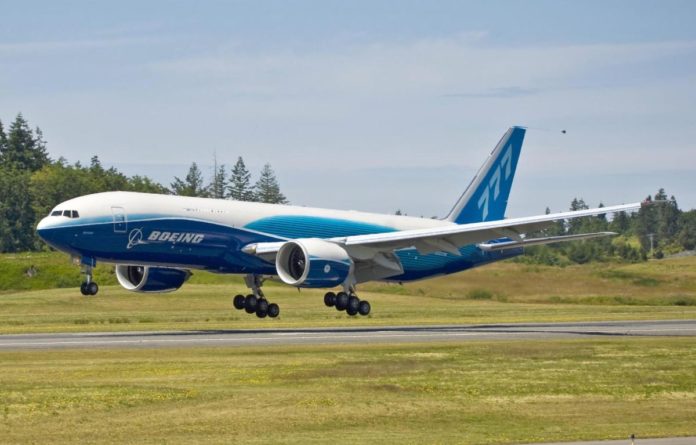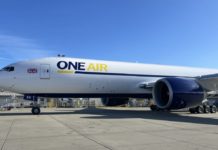Plane maker Boeing is forecasting strong demand for air cargo services over the next two decades in its 2022 World Air Cargo Forecast (WACF), published on 9 November.
It expects traffic to double, while the world freighter fleet will expand by more than 60%.
The latest WACF projects that the world’s cargo fleet will require nearly 2,800 production and converted freighters for growth and replacement up to 2041. This will be made up of about 940 new freighters and about 1,855 conversions of passenger aircraft.
With cargo traffic doubling over the forecast period, operators will need to switch to more capable and fuel-efficient jets like the 777-8 freighter to meet demand.
Overall, the global freighter fleet will grow by more than 1,300 airplanes to more than 3,600 jets over the next two decades.
Currently, there are about 300 more freighters than existed in 2019, an increase of well over 15%, said Boeing. Utilization of the fleet also rose, and the current average number of flight hours for aircraft is still about 25 to 30% above pre-pandemic levels.
About 1,400 cargo aircraft will need to be replaced in the coming decades including many were used over the course of the pandemic that were probably past normal retirement age, including some that came out of the desert to serve as “emergency” freighters.
Over half the global freighter fleet is at least 20 years old with over 350 aircraft needing replacement, says Boeing.
At a press conference to launch the latest WACF, Boeing vice president of commercial marketing, Darren Hulst, said: “While the air cargo market is returning to a more normal pace after historic demand in the last two years, structural factors including express network growth, evolving supply chainstrategies and new cargo-market entrants are driving sustained freighter demand.
“In the global transportation network, air freighters will continue to be a critical enabler to move high-value goods, in increased volume across expanding markets.”
The 2022 WACF also predicts that the Asia-Pacific region will take delivery of nearly 40% of all freighters, both new and converted.
It added that while dedicated freighters make up just 8% of the total commercial aircraft fleet worldwide, they continue to carry more than half of all air cargo, with passenger airplanes carrying the remainder as belly cargo.
Hulst said that at one point over 70% and maybe closer to 80% of air cargo capacity was provided by dedicated freighters around the world, much higher than the long term average of around 50-60%.
Hulst described cargo as “relatively the bright spot in commercial aviation since the beginning of the pandemic.” Revenues were 70% higher on air cargo in 2021 than they were in 2019 and should roughly maintain those levels in 2022. It was, he said “a testament to the reliability and speed of air cargo as a function of trade, of moving goods and keeping supply chains moving.”
In recent months, there had been some changes to the dynamics of the marketplace, he continued. Some of the pandemic strains are easing in air cargo, partially due to economic effects and also because belly capacity is returning. However: “As schedules move closer and closer to pre pandemic levels remarkably, the revenues, the yields continue to stay very elevated, demonstrating again the value of cargo. But some of those pandemic effects are easing off from unprecedented highs. Economic uncertainty around the world continues to be a focus and that will probably have some effect in the near term on air cargo, on trade, especially as the key driver for air cargo.”
He added: “We continue to see the strength of e commerce networks developing around the world, especially in emerging markets…And it requires kind of a basic level of aircraft to support those e-commerce frameworks, those air networks to support the demand that continues to grow especially in emerging markets.”
Big e commerce names are joining with airlines or creating airlines to create their own networks to satisfy tremendous demand, Hulst predicted.
New operators are entering the cargo space, including those that haven’t operated freighters in the past or who want to grow their freighter networks or want to diversify into carrying freight in addition to passengers. Hulst estimated that there are now around 40 new cargo operators.
Boeing believes that air cargo traffic will grow about 4% per year for the next 20 years, slightly higher than passenger traffic. Growth in the number of freighter aircraft will be about the same, at about 2.5 to 3%.
While flows such as Asia to North America or Asia to Europe remain important, the highest market growth rate will be within East Asia, Hulst forecast. This market would, become the third largest flow by 2041, he predicted.
Also, over the last three years domestic air tonnage in the US market has grown by almost a quarter, relative to only about 1% growth in trucking.
Meanwhile, inter-European express shipments have almost tripled since the beginning of the century.
The complete 2022 World Air Cargo Forecast can be found at: www.boeing.com/wacf.
((Pic – Boeing 777F))











